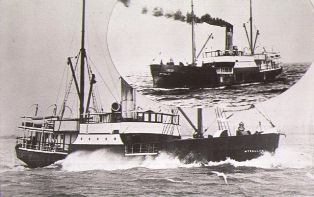WIGHTON, John Gordon (1885-1924)  Wiki.jpg)
John Wighton
John Wighton, marine engineer, was drowned when the ship,
SS Wyrallah was sunk at Port Phillip Heads. ‘Jack’ Wighton was one of two sons of a solicitor, James Wighton and his wife Janet nee Miller to attend Geelong College. He entered the school as a day student in 1895 attending until 1903 and was a notable member of the 1902 and 1903 1st XVIII Football Teams.
The following obituary appeared in
Pegasus in May 1924 after the accident:
‘The fantasy of revolving wheels had a special significance for ‘Jack’ Wighton from childhood days, when he was frequently found in a secluded place about his parents' home playing with mechanical toys, or anything that was of a mechanical nature.
Right through his life his mind and hand worked in perfect unison, and his aptitude for engineering work was apparent to his parents long before he left Geelong College, where he was educated. Born in Melbourne, he came to Geelong with his parents when he was about five years of age. The Geelong College formed his training ground until he was about 17 years of age, and during that time he had gained popularity with his chums for his fine characteristics, both in the school, and on the field of sport.
Football and swimming interested him most, particularly the former, and after leaving the College he was induced to join the old Marylebone football team, and his success as full-back in the College team was repeated in the Junior Association matches. He was also chosen to play in the League first eighteen, but as he was then apprenticed to the firm of J C Brown and Co, for five years, he was reluctant to actively identify himself with the strenuous pastime, especially as it was played in League football.
His ambition was to gain his certificates for engineering, so that he could prepare himself for marine engineering and his vocation. Although his employers and fellow employees realised that he was naturally engrossed in his work, they encouraged him in sport, and encouraged his manliness and sterling character, and there was general regret expressed when he left the employ of Messrs J C Brown and Co. He gained his certificate as a chief engineer.
His seafaring work then commenced, and he was engaged in the engineering departments of the following coastal vessels and bay steamers: - Riverina; Moorabool, Coogee, Ulimaroa, Excelsior, Courier and Hygeia. For about 12 years past he has been employed on the Wyrallah on the Gipplsland Lakes traffic and, on 8 April, his career was cut short when he was one of the members of the crew who drowned at the Heads owing to the collision with the collier, Dilkera.
One of the outstanding episodes of the sinking of the 'Wyrallah' was Jack Wighton’s courage and bravery in the face of death, and his regard for the safety of the passengers and crew.’ His brother,
James Robert Nichol Wighton (1891-1956) was educated at the College from 1900 to 1908.

S.S. Wyrallah
The ‘Wyrallah’ was on its usual run from Melbourne to the Gippsland Lakes with a general cargo, including timber, benzene and confectionery under the command of first time Captain, Richard Bracken, when, at 10.20 pm on 8 April 1924, the ship collided with the inward bound steamship ‘SS Dilkera’ just inside Port Phillip Heads. Aboard the ‘Wyrallah’ were two passengers and a crew of thirteen. The ‘Wyrallah’ was nearly cut in half by the ‘Dilkera’, which had been travelling at full speed when it first sighted the ‘Wyrallah’. ‘Wyrallah’ sank within 10 minutes.
‘Wyrallah’ was an iron, screw driven, steam ship, 140 ft long, 206 nett tons, originally built by Mort’s Dock and Engineering Co, Balmain, Sydney in 1887 for the northern rivers of NSW. The ship had been chartered by Gippsland Steamers from Huddart Parker Ltd. ‘Wyrallah's’ master was blamed by the Court of Marine Inquiry for the wreck as his vessel was on the wrong side of the Shipping Channel. The vessel’s location was later located by divers in 23 metres of water and the site declared a protected wreck by Heritage Victoria. Robert G. Menzies, later Prime Minister of Australia, and whose sons attended Geelong College, acted for the Crown Law Department in relation to the wreck.